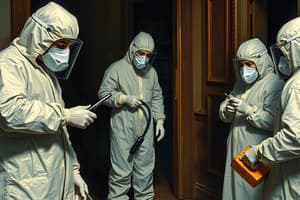Podcast
Questions and Answers
What is the primary purpose of a decontamination zone?
What is the primary purpose of a decontamination zone?
- To treat contaminated personnel and equipment
- To prevent the spread of contaminants, protect people, equipment, and the environment (correct)
- To isolate contaminated areas from the rest of the environment
- To dispose of contaminated materials
What is the 'hot zone' in a decontamination zone?
What is the 'hot zone' in a decontamination zone?
- The area where personnel and equipment are safe to enter
- The area where personnel and equipment are cleaned and disinfected
- The area where the contaminant is present, and contamination is most likely to occur (correct)
- The area where decontamination takes place
What is the first step in the decontamination zone procedure?
What is the first step in the decontamination zone procedure?
- Removal of outer garments (correct)
- Showering and washing
- Monitoring and sampling
- Disinfection of equipment
What is the purpose of the 'warm zone' in a decontamination zone?
What is the purpose of the 'warm zone' in a decontamination zone?
What is the last step in the decontamination zone procedure?
What is the last step in the decontamination zone procedure?
What is the purpose of disinfecting equipment in a decontamination zone?
What is the purpose of disinfecting equipment in a decontamination zone?
What is the 'cold zone' in a decontamination zone?
What is the 'cold zone' in a decontamination zone?
Why is monitoring and sampling important in a decontamination zone?
Why is monitoring and sampling important in a decontamination zone?
Flashcards are hidden until you start studying
Study Notes
What is a Decontamination Zone?
A decontamination zone, also known as a decon zone, is a designated area where personnel and equipment are cleaned and disinfected to prevent the spread of contaminants.
Purpose of a Decontamination Zone
The primary purpose of a decontamination zone is to:
- Prevent the spread of contaminants, such as chemical, biological, or radiological agents, from one area to another
- Protect people, equipment, and the environment from contamination
- Ensure that personnel and equipment are properly cleaned and disinfected before entering or exiting a contaminated area
Types of Decontamination Zones
There are three types of decontamination zones:
- Hot Zone: The area where the contaminant is present, and contamination is most likely to occur.
- Warm Zone: The area between the hot zone and the clean zone, where decontamination takes place.
- Cold Zone: The area that is free of contaminants, and where personnel and equipment are safe to enter.
Decontamination Zone Procedures
The following procedures are typically followed in a decontamination zone:
- Removal of Outer Garments: Personnel remove their outer garments, such as clothing and boots, to prevent re-contamination.
- Showering and Washing: Personnel shower and wash their bodies to remove any contaminants.
- Disinfection of Equipment: Equipment is disinfected using approved methods, such as sterilization or disinfectant sprays.
- Monitoring and Sampling: The decontamination zone is monitored and sampled to ensure that the decontamination process is effective.
Importance of Decontamination Zones
Decontamination zones are crucial in various settings, including:
- Hazardous material response
- Chemical, biological, radiological, and nuclear (CBRN) response
- Healthcare facilities
- Industrial settings
- Environmental cleanup operations
By establishing a decontamination zone, the risk of contamination is significantly reduced, and the safety of personnel, equipment, and the environment is ensured.
Decontamination Zone
- A designated area where personnel and equipment are cleaned and disinfected to prevent the spread of contaminants.
Purpose
- Prevent the spread of contaminants (chemical, biological, or radiological agents) from one area to another.
- Protect people, equipment, and the environment from contamination.
- Ensure personnel and equipment are properly cleaned and disinfected before entering or exiting a contaminated area.
Types of Decontamination Zones
- Hot Zone: Area where the contaminant is present, and contamination is most likely to occur.
- Warm Zone: Area between the hot zone and the clean zone, where decontamination takes place.
- Cold Zone: Area that is free of contaminants, and where personnel and equipment are safe to enter.
Decontamination Zone Procedures
- Personnel remove outer garments (clothing and boots) to prevent re-contamination.
- Personnel shower and wash their bodies to remove contaminants.
- Equipment is disinfected using approved methods (sterilization or disinfectant sprays).
- The decontamination zone is monitored and sampled to ensure the decontamination process is effective.
Importance
- Decontamination zones are crucial in hazardous material response, CBRN response, healthcare facilities, industrial settings, and environmental cleanup operations.
- Establishing a decontamination zone significantly reduces the risk of contamination and ensures the safety of personnel, equipment, and the environment.
Studying That Suits You
Use AI to generate personalized quizzes and flashcards to suit your learning preferences.




